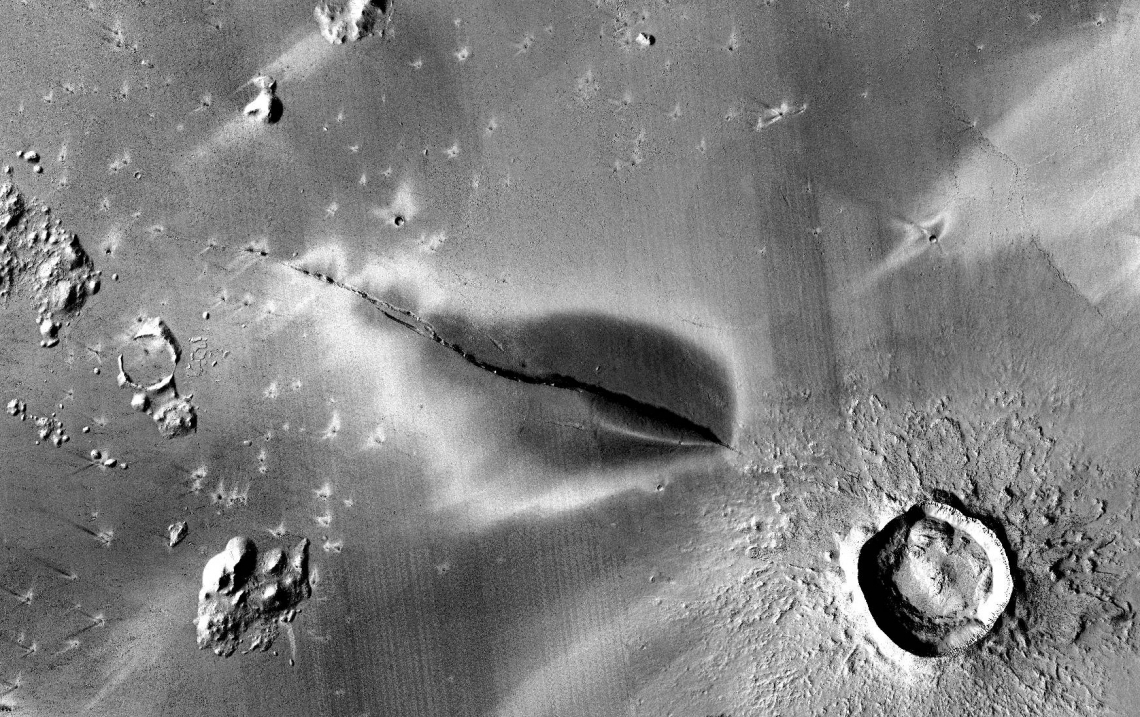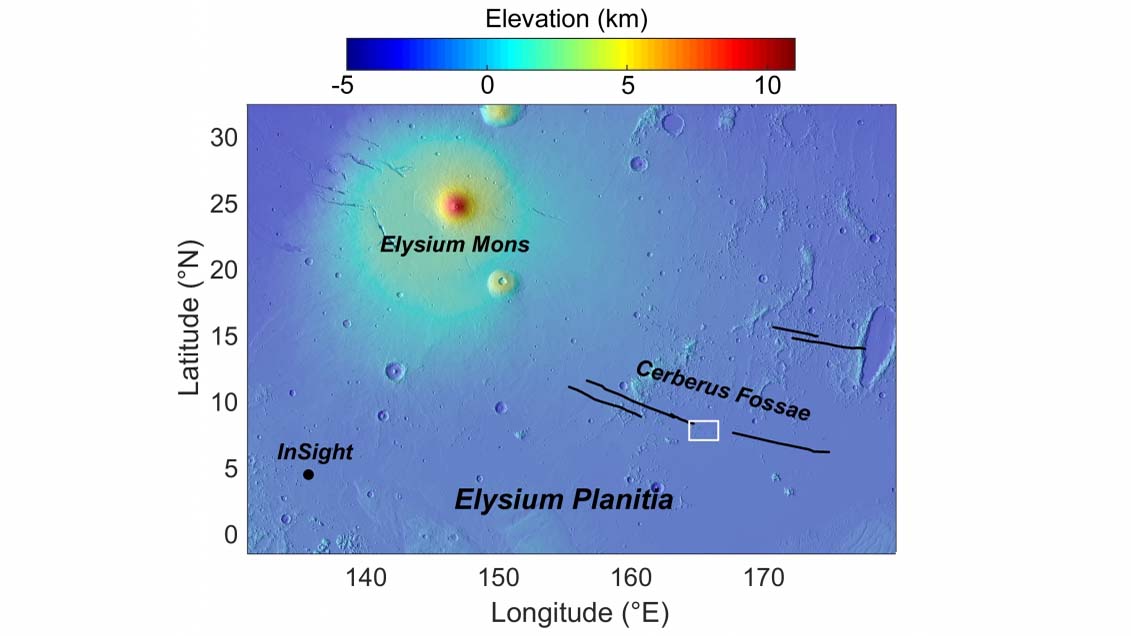Mars may still be volcanically active, study finds

Evidence of what may be the youngest eruption seen yet on Mars suggests the Red Planet may still be volcanically active, raising the possibility it was recently habitable, a new study finds.
Most volcanism on Mars occurred between 3 billion and 4 billion years ago, leaving behind giant monuments such as Olympus Mons, the tallest mountain in the solar system. At 16 miles (25 km) high, Olympus Mons is about three times as tall as Mount Everest, Earth's highest mountain.
Previous research suggested the Red Planet may still have flared with smaller volcanic eruptions as recently as 2.5 million years ago. Now scientists have found evidence that Mars may still be volcanically active, with signs of an eruption within the past 50,000 years or so.
"This being the youngest documented volcanic eruption on Mars, the potential that Mars could potentially be volcanically active at present is exciting," study lead author David Horvath, a planetary scientist now at the Planetary Science Institute in Tucson, Arizona, told Space.com.
Related: 10 incredible volcanoes in our solar system (images)
Using data from satellites orbiting Mars, researchers analyzed relatively featureless equatorial plains of a region known as Elysium Planitia. They discovered a previously unknown smooth dark volcanic deposit about 8 miles (13 kilometers) wide, covering an area slightly larger than Washington, D.C. It surrounds a volcanic fissure about 20 miles (32 km) wide, one of the cracks making up the fissure system known as Cerberus Fossae.
"I first noticed this volcanic deposit when I was looking over some images of this region. I had looked at this area many times before but somehow had always overlooked this feature," study senior author Jeff Andrews-Hanna, a planetary scientist at the University of Arizona at Tucson, told Space.com. "Once this odd dark deposit centered on a volcanic fissure came to my attention, I knew it was telling us something important."
Get the Space.com Newsletter
Breaking space news, the latest updates on rocket launches, skywatching events and more!
Specifically, this deposit looked unlike anything else found in the region, or indeed on all of Mars, Andrews-Hanna said. Instead, it more closely resembled features created by older volcanic eruptions on the moon and Mercury.
Related: Weird volcanoes are erupting across the solar system

Most signs of volcanism previously seen in Elysium Planitia and elsewhere on Mars consisted of lava flowing across the surface, similar to recent eruptions in Iceland. However, this newfound eruption looks different — it appears to be a relatively fresh deposit of ash and rock on top of surrounding lava flows.
This volcanic deposit may be the most recent seen yet on Mars, the scientists noted. "If we were to compress Mars' geologic history into a single day, this would have occurred in the very last second," Horvath said in a statement.
The researchers found the properties, composition and distribution of material from the eruption match what they would expect from a pyroclastic eruption — an explosive outburst of magma driven by expanding gases, not unlike the opening of a shaken can of soda. On Earth, deadly avalanches of scalding ash, toxic gas and pulverized rock from pyroclastic eruptions, known as pyroclastic flows, entombed the ancient Roman cities of Pompeii and Herculaneum after Mount Vesuvius erupted in 79 AD.
"This eruption could have spewed ash as high as 10 kilometers (6 miles) into the Martian atmosphere," Horvath said in the statement.
Although there are numerous examples of explosive volcanism on Mars, those occurred long ago. It is possible such pyroclastic deposits were once more common, but most have eroded or gotten buried, Horvath said.
The newfound volcanic deposit is located about 1,000 miles (1,600 km) from NASA's InSight lander, which has investigated tectonic activity on Mars since 2018. Two Marsquakes InSight detected in the region originated around Cerberus Fossae.
"We now know that this region is both the most volcanically and seismically active area on the planet today," Andrews-Hanna said.
Previous research suggested magma might still be moving deep underground the region around Cerberus Fossae.
"If lava was erupting to the surface only 50,000 years ago, and the area is still rumbling with seismicity today, that means that it could erupt again," Andrews-Hanna said.
One potential mechanism driving this eruption was gases trapped in magma, said study co-author Pranabendu Moitra, a research scientist at the University of Arizona. Another was contact between magma and permafrost, with ice in the permafrost melting to water, mixing with the magma, and then vaporizing, triggering a violent explosion, he added.
Intriguingly, this newfound eruption also happened only 6 miles (10 km) from the youngest large impact crater on Mars — a meteor crater 6 miles (10 km) wide named Zunil. "The ages of the eruption and the impact are indistinguishable, which raises the possibility, however speculative, that the impact actually triggered the volcanic eruption," Moitra said in the statement.
Prior work found that on Earth, seismic waves from large quakes can force magma stored beneath the surface to erupt. The collision that created Zunil could potentially have shaken Mars like an earthquake, triggering an eruption, Moitra suggested.
"To be clear, we cannot state that the eruption was triggered by an impact — only that the timing and magnitude are right," Andrews-Hanna said.
These new findings raise the possibility the warmth from recent volcanic activity could have made the Red Planet more habitable to life as we know it. Magma rising from deep underground could have melted ice near the surface, which could have provided favorable conditions for microbial life fairly recently.
"This does not necessarily confirm past life on Mars, but does imply an environment conducive to habitability," Horvath said.
The big question the scientists now have, Andrews-Hanna said, is "why is this particular area such a hotspot for activity on Mars?"
"Mars has a number of giant volcanoes, including nearby Elysium Mons, but this eruption and the volcanic fissures it is associated with are in an otherwise featureless plain," Andrews-Hanna added. "Is this area underlain by a plume of hot mantle material? Will the next great Martian volcano rise from this spot?"
The scientists detailed their findings online April 21 in the journal Icarus.
Originally published on Space.com.
Join our Space Forums to keep talking space on the latest missions, night sky and more! And if you have a news tip, correction or comment, let us know at: community@space.com.

Charles Q. Choi is a contributing writer for Space.com and Live Science. He covers all things human origins and astronomy as well as physics, animals and general science topics. Charles has a Master of Arts degree from the University of Missouri-Columbia, School of Journalism and a Bachelor of Arts degree from the University of South Florida. Charles has visited every continent on Earth, drinking rancid yak butter tea in Lhasa, snorkeling with sea lions in the Galapagos and even climbing an iceberg in Antarctica. Visit him at http://www.sciwriter.us









